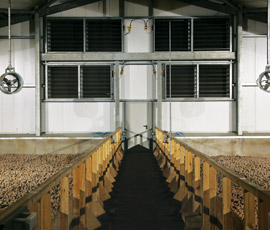Potato growers consider leaving crops until spring

A tumultuous year of bad weather has wreaked havoc in the potato sector, with yields down 15% and production costs a hectare up 8.8% for ware and 6.5% for processing.
These figures, from a Potato Council-funded analysis carried out by Andersons and Bidwells, coincide with a message from those in the industry urging growers to scrutinise their production costs in a bid to reduce the effects of yet another wretched season.
Currently (mid-November) about 13% still has to be lifted, with the expectation that some growers will leave the crop in the ground during the winter in the hope that ground conditions might improve.
Variable costs for the 2012 harvest increased by 13% from 2011. This is being primarily attributed to increased fungicide use because of high blight pressure.
Bidwells senior agribusiness consultant Neil Cameron admits that the figures could never be completely accurate for each grower, but give a good indication on the year in general.
| Plea to attend emergency summit |
|---|
| The Potato Council is calling on growers to attend an emergency summit being organised in the new year to rescue the industry following three torrid years. Potato Council chairman Allan Stevenson said solidarity within the industry was needed to address the current challenges and help develop solutions to form a more sustainable and profitable sector. “We in Great Britain have a very modern and innovative potato sector that leads the world in many ways, but we are laggards in making sure the supply chain works effectively and fairly. This has to change in the season ahead,” said Mr Stevenson. The plan (Potato Council Business Plan 2013-2016) unveiled at the Seed Industry event captured the thoughts of more than 90 industry players, focusing on agreed priorities, including addressing the apparent yield plateau, developing better storage, securing plant health, supporting seed, countering fresh decline and supporting processing. Challenging the industry, Mr Stevenson concluded: “We have what we believe to be a well-balanced and highly-focused plan that takes the industry on a journey towards profitability and sustainability.” |
2012 costs
“Individual growers’ cost of production a tonne will vary greatly depending on the yield achieved this year. The Potato Council has estimated a 15% yield reduction, which will result in 2012 potato production costs a tonne (including rent and finance) increasing by 28.8% against 2011 for ware and 27.8% for processing.”
Average cost of production (including rent and finance) for 2012 are £190/t (ware) and £157/t (processing).
“Too few people make the calculation of their own cost of production. You need a handle on this figure so you can make the correct decision when it comes to contracts and your strategy for each year,” he says.
It’s been an expensive year for growing potatoes, but according to the Potato Council it’s been a good year to grow potatoes on the open market. Open market prices on the whole are more than compensating for increased growing costs.
Growers on a low-margin fixed price contract are likely to struggle to make a margin, especially where yields have been low; this has been exacerbated where yields have fallen below the contracted tonnages. Growers need to consider the average returns over a number of years when considering marketing options.
One of the key areas targeted for saving money and reducing costs was improving storage efficiency.
Adrian Cunnington, head of Sutton Bridge Crop Storage, says examining storage risk factors – from reducing soil content to controlling the air flow into a store – can make a huge difference.
“Investing in your storage can help immensely, particularly in a year like the one we’ve just had. There are many outdated stores that are increasing costs, either by poor storage of the potatoes, leading to losses, or the use of energy. Growers need to be willing to invest and see it as a long-term investment. Over a period of time they will see the benefits in costs.
“Some of the most useful data we have shows cold store energy use. There’s a huge range in the amounts used across the country (relative to each store), which shows there are savings to be made.
“I’m urging people to get in and measure their costs. There are many simple things that farmers can do that will ultimately save them a lot of money.”
Mr Cunnington says investing in an inverter is one way to reduce costs. “We don’t want a one-size-fits-all system. We need lots of air when we dry it, then when we get to the holding period we don’t need that amount of air. So we need some way of controlling that.
“An inverter is basically a dimmer switch for your fan, so you can turn it down from 60cfm to 30cfm. By using this simple piece of kit it’s possible to save a lot of energy.
“If you reduce 50% of your air volume then your costs are reduced to 28% of the full amount, which can be hugely advantageous.”
Inverters weren’t around 20-30 years ago and many were not fitted because of poor electronics, but they’ve come on hugely in the past few years, improving our level of control and ultimately the cost of controlling the stores, he says.
Potato growers must become price makers if sector is to thrive

